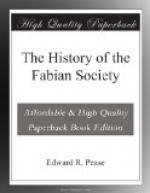It may be added that Mr. Shaw was patted on the back by a subsequent speaker, Mr. John Wilson, of the Durham Miners, for many years M.P. for Mid-Durham, and by no means an habitual supporter of Socialists.
The stout volume in which the proceedings are published is now but seldom referred to, but it is a somewhat significant record of the intellectual unrest of the period, an indication that the governing classes even at this early date in the history of English Socialism, were prepared to consider its claims, and to give its proposals a respectful hearing.
* * * * *
The early debates in the Society were in the main on things abstract or Utopian. Social Reconstruction was a constant theme, Hubert Bland outlined “Revolutionary Prospects” in January, 1885, and Bernard Shaw in February combated “The proposed Abolition of the Currency.”
On March 6th a new departure began: a Committee was appointed to collect “facts concerning the working of the Poor Law,” with special reference to alleged official attempts to disprove “great distress amongst the workers.” It does not appear that the Report was ever completed.
On March 20th Sidney Webb read a paper on “The Way Out,” and on the 1st May he was elected a member along with his Colonial Office colleague Sydney Olivier. On May 15th is recorded the election of Harold Cox, subsequently M.P., and now editor of the “Edinburgh Review.”
The Society was now finding its feet. On April 17th it had been resolved to send a delegate “to examine into and report upon the South Yorkshire Miners”! And on the same day it was determined to get up a Soiree. This gathering, held in Gower Street, was memorable because it was attended by Mrs. Annie Besant, then notorious as an advocate of Atheism and Malthusianism, the heroine of several famous law cases, and a friend and colleague of Charles Bradlaugh. Mrs. Besant was elected a member a few weeks later, and she completed the list of the seven who subsequently wrote “Fabian Essays,” with the exception of Graham Wallas, who did not join the Society until April, 1886.[12]
But although Sidney Webb had become a Fabian the scientific spirit was not yet predominant. Bernard Shaw had, then as now, a strong objection to the peasant agriculture of his native land, and he submitted to the Society a characteristic leaflet addressed: “To provident Landlords and Capitalists, a suggestion and a warning.” “The Fabian Society,” it says, “having in view the advance of Socialism and the threatened subversion of the powers hitherto exercised by private proprietors of the national land and capital ventures plainly to warn all such proprietors that the establishment of Socialism in England means nothing less than the compulsion of all members of the upper class, without regard to sex or condition, to work for their own living.” The tract, which is a very brief one, goes on to recommend the




